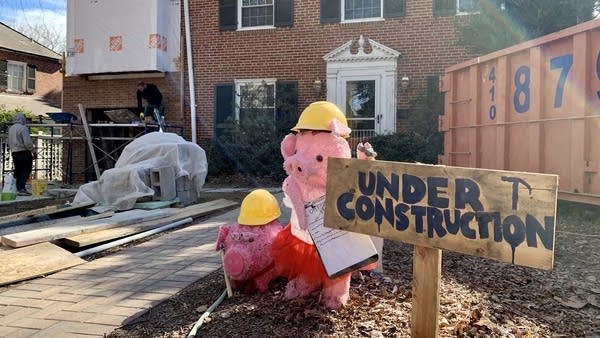
“You can’t miss us,” Matt Hampton said, giving directions to his house in suburban Baltimore. He was right. There was a huge, orange dumpster in the front yard, lumber and cinder blocks piled up on the driveway and a worker on scaffolding laying bricks for what looked like a new garage.
“And it gets worse,” Hampton said, laughing.
Like a lot of home improvement projects these days, Hampton said this one started with the pandemic and the chaos of working at home with two kids, now 14 and 11.
“Figuring out workarounds for that got a little frustrating,” he said. “Initially, my wife was working in a window bench.”
So, the family decided to hire a contractor to build dedicated office space and — while they were at it — a new laundry room, guest room and kitchen. But why stop there?
“These old houses, they’re charming, but they are not without their sort of lack of modern conveniences, if you will,” Hampton said.

Conveniences like mudrooms and big closets. So they decided to add those too. Before long, Hampton said, the project “blossomed” into a roughly $450,000 addition. They did consider buying a bigger house further outside the city, he said, but found that they likely would have had to spend even more.
“When we did the math and carried the 1, this was a fairly cheaper option and didn’t require us to uproot our kids, who are very entrenched in the neighborhood,” Hampton said.
Sealing the deal, an appraiser told Hampton the renovations would probably pay for themselves if they sold the house.
“At a minimum, we’d probably break even with where we’re at,” Hampton said. “That was actually a big deciding factor” in making the investment.
Most home improvement projects, though, do not pay for themselves, at least according to a new study from “Today’s Homeowner,” a home improvement TV show and website. Researchers scoured Redfin listings to estimate how much value different improvements added to a home, based on its sale price. Then, they divided the extra value by the average cost of the project to determine the expected return on investment.
Out of 34 kinds of remodeling projects in 70,000 homes, only one project broke even: replacing a garage door.
“Unfortunately, the main finding was that no home improvement project actually adds value to the house above and beyond the cost of what it took to go ahead and do that project,” said Shadi Bushra, a data journalist who was involved in the study.
Other improvements came close to breaking even. New wood windows returned 96% of the cost; a screened-in porch: 93%. But the average for all projects was just 69%. And with some of the most common improvements — like an upscale kitchen or bathroom remodel — homeowners recovered only about half of the cost.
“Bathrooms and kitchens, as popular as they are, they are some of the poorest investments you can make,” Bushra said.
Financially speaking, that is. Finishing a basement had the smallest return on investment at just 23%. The study looked at professional remodeling projects, but the ROI on DIY might be higher, Bushra said. It’s also hard to separate all the factors that go into a home’s price. That finished basement might make all the difference for the right buyer.
“Right now, the study of resale value for any individual projects is much more of an art than a science,” said Carlos Martín, who follows the remodeling industry at Harvard University’s Joint Center for Housing Studies.
The center projects total spending on home improvement and repairs will climb to $485 billion this year, though growth is expected to slow amid a cooler housing market and concerns about a potential recession.
Martín pointed to research showing higher returns on remodeling. The National Association of Realtors estimates that bathroom and kitchen renovations can return 70% to 75% of costs, while converting basement space can recoup 86%.
Plus, resale price is just one way to measure value, Martín said.
“It could also be that project that you do decreases your energy bills or it reduces your insurance premiums,” he said. “It’s also because it’s valuable to you as a consumer, and, at the end of the day, that’s really what matters the most.”
The Realtors group calls that the joy score.
Cynthia Bliss and Bill Clewell, both retired schoolteachers in Baltimore, just finished installing a new laundry room and minikitchen on their second floor. Their joy score?
“It’s like a 10, don’t you think?” Bliss said. “We’re just thrilled with it.”

No more hauling laundry two flights of steps to and from the basement.
“Walk right out of the bedroom, and there’s your laundry room,” Bliss said. “It’s the best thing.”
They also recently replaced a large, wooden deck with composite materials, which “Today’s Homeowner” lists as one of the more valuable additions — recovering an estimated 87% of the cost. But Bliss doubts they’ll ever get back what they’ve put into the house over the years.
“You can’t rely on that,” she said. “Because what we think is important, somebody else might say, ‘Oh, the deck? Well, that is great, but I didn’t need that big of a deck.’”










